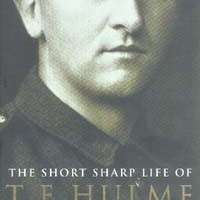The importance of T.E. Hulme, by Roger Kimball
The history of philosophers we know, but who will write the history of the philosophic amateurs and readers?” Thus did the Imagist poet and essayist T. E. Hulme begin “Cinders,” a posthumously published collection of notes and aphorisms about art, life, and language that he scribbled in his early twenties while traveling across Canada working on railways, farms, and in timber mills. Hulme (the name is pronounced “Hume”) was himself a conspicuously philosophical amateur. Or perhaps one should say “amateur philosopher” (I use “amateur,” as he did, in its most flattering sense). Among much else, he was a translator and—for a few years, anyway–champion of the work of the French philosopher Henri Bergson; he was an early and voluble reader of Edmund Husserl, G. E. Moore, Alexius Meinong, Georges Sorel, Max Scheler, and other difficult, path-breaking thinkers; he was the first to disseminate in England Wilhelm Worringer’s ideas about the “urge to abstraction” in art; he was an enthusiastic proponent of certain strains of avant-garde art, an implacable critic of others. Above all, Hulme was a committed if idiosyncratic Tory, an ardent propagandist for “classicism” and “the religious attitude,” an adamant scourge of pacificism and anything that he could construe as “romanticism” or “humanism.”
Today, Hulme merits an extended footnote in the history of English modernism— the high modernism of T. S. Eliot, Ezra Pound, and Wyndham Lewis. In her recent edition of Hulme’s writings for Oxford’s Clarendon Press,[1] Karen Csengeri calls Hulme “one of the most misunderstood figures in twentieth-century letters.” He is at any rate one of the most fugitive. Hulme is one of those curious figures whose influence outruns his achievement—or at least whose achievement is difficult to reckon by the usual standards. The aesthetic movement with which he is most closely associated—Imagism—is, as René Wellek observed, based on ideas that are “extremely simple and even trite.” Poetry, Hulme wrote in one typical exhortation, should be “a visual concrete” language that “always endeavors to arrest you, and to make you continuously see a physical thing, to prevent you gliding through an abstract process.”
read the complete article in The New Criterion
